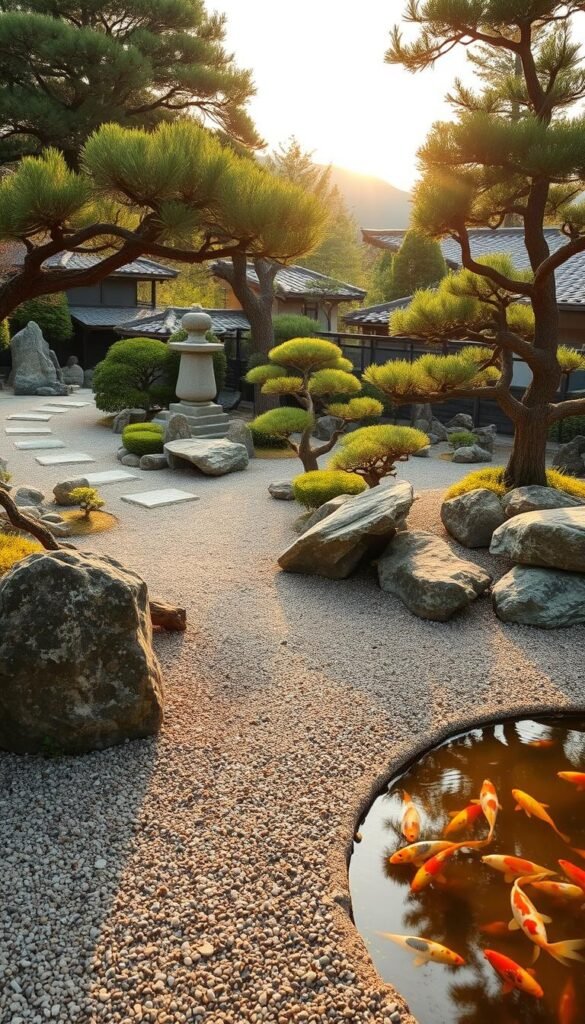Imagine stepping into an outdoor space where every stone and shrub whispers calmness. For over fourteen centuries, carefully arranged landscapes have served as living art that quiets the mind while celebrating nature. These spaces aren’t just pretty backyards—they’re carefully orchestrated environments blending philosophy, artistry, and practicality.
Master creators like Masuno Shunmyou—a revered temple leader and landscape artist—show how ancient methods remain powerful today. His acclaimed projects worldwide prove these concepts work in bustling cities and quiet suburbs alike. Research even shows such spaces lower stress levels while helping people reconnect with natural rhythms.
You’ll uncover how simple elements like raked gravel or strategically placed rocks create visual harmony and mental clarity. Whether you’re refreshing a patio or planning a larger project, these ideas adapt to any scale. Discover how centuries-old approaches can help you build a personal oasis that nourishes both eyes and soul.
Understanding the History and Philosophy of Japanese Gardens
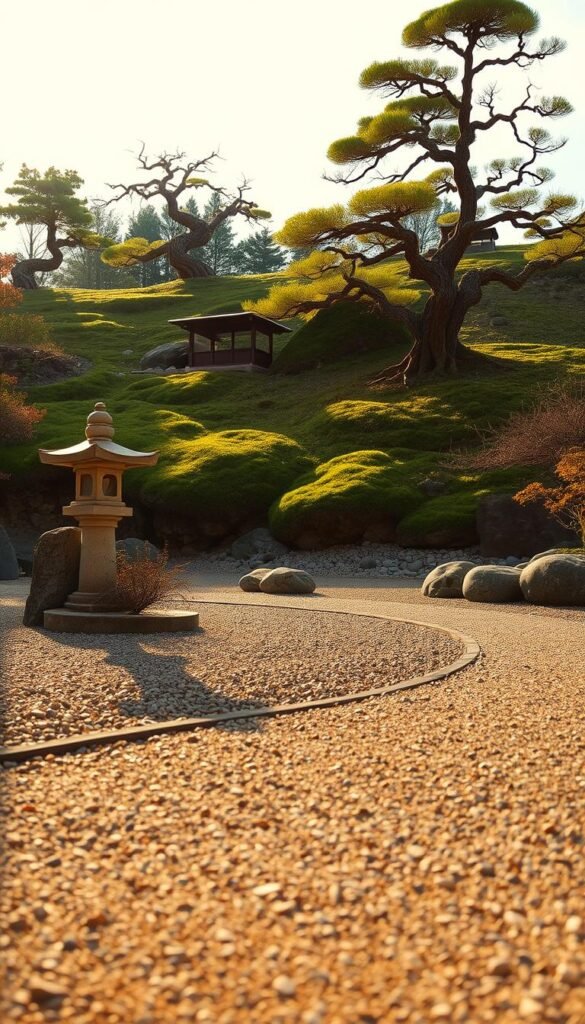
For over a millennium, carefully crafted landscapes have served as bridges between earth and spirit. These spaces began as sacred grounds where ancient Shinto, Buddhist, and Taoist ideas merged. By the Heian period (794-1185), places like Kyoto’s Shinden Garden showed how harmony with nature could shape human experience.
Ancient Traditions and Spiritual Inspirations
Early creators saw gardens as reflections of cosmic order. Monks known as ishidate-so transformed simple elements into spiritual maps. Rocks became mountains, gravel mimicked rivers, and empty spaces invited contemplation. This philosophy still guides modern layouts worldwide.
Zen Buddhism and Its Impact on Garden Design
Zen teachings reshaped landscapes into tools for enlightenment. The iconic Ryoan-ji Temple’s dry garden uses 15 rocks and raked sand to spark introspection. As Head Priest Masuno explains:
“A true Zen space isn’t just arranged nature—it’s a mirror of the mind’s clarity.”
This minimalist approach proves simplicity holds deep meaning. Whether in bustling cities or quiet backyards, these principles help you create spaces that breathe calmness into daily life.
Exploring Key Elements of a Serene Japanese Garden
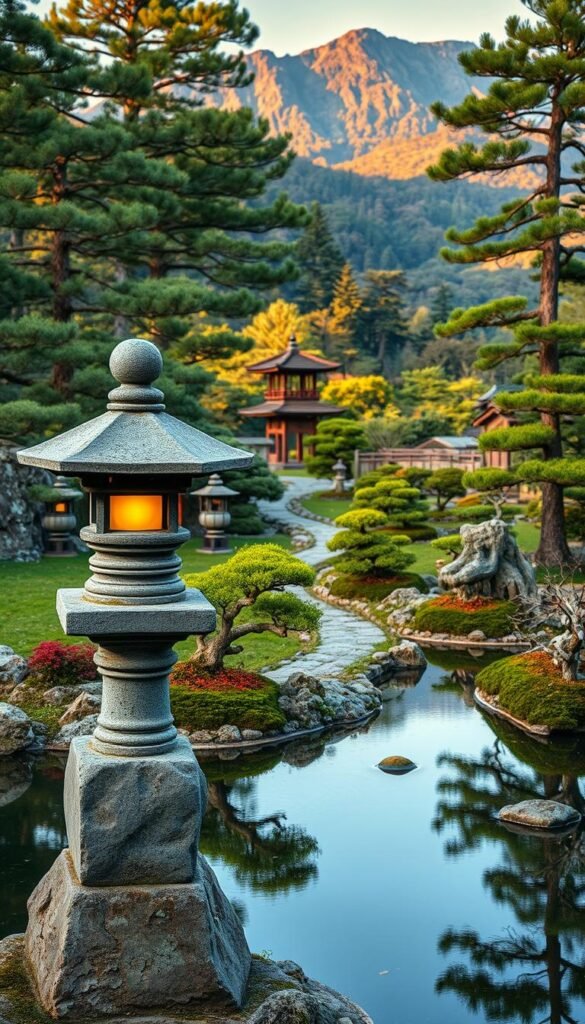
Three core principles transform ordinary spaces into peaceful retreats. These concepts work together to craft environments that feel both intentional and effortless. Let’s break down how they shape every detail.
Balance, Minimalism, and Symbolism
The principle of “wa” teaches harmony between elements. Imagine pairing rugged stones with flowing water or balancing open areas with clustered plants. This equilibrium creates visual calmness without rigid symmetry.
Minimalism strips away excess to highlight nature’s beauty. Instead of filling every corner, leave room for imagination. A single maple tree or a lone lantern often speaks louder than crowded flower beds.
Every item carries hidden meaning. Vertical rocks might mimic mountain peaks, while circular patterns in gravel suggest endless cycles. Even empty spaces matter—they represent potential and pause.
Seasonal Variations and Natural Materials
Great landscapes celebrate change. Cherry blossoms shout spring joy, while fiery maples announce autumn’s arrival. Plan for year-round interest using plants that shift colors or textures monthly.
| Element | Seasonal Role | Material Choice |
|---|---|---|
| Stone | Provides structure in winter | Weather-resistant granite |
| Water | Reflects summer skies | Natural stone basins |
| Plants | Offers autumn hues | Mosses & evergreen shrubs |
Choose materials that age gracefully. Weathered wood gains character, while moss softens stone edges over time. These organic changes remind us that beauty evolves.
Japanese Garden Design Secrets: Creating Serenity with Traditional Techniques
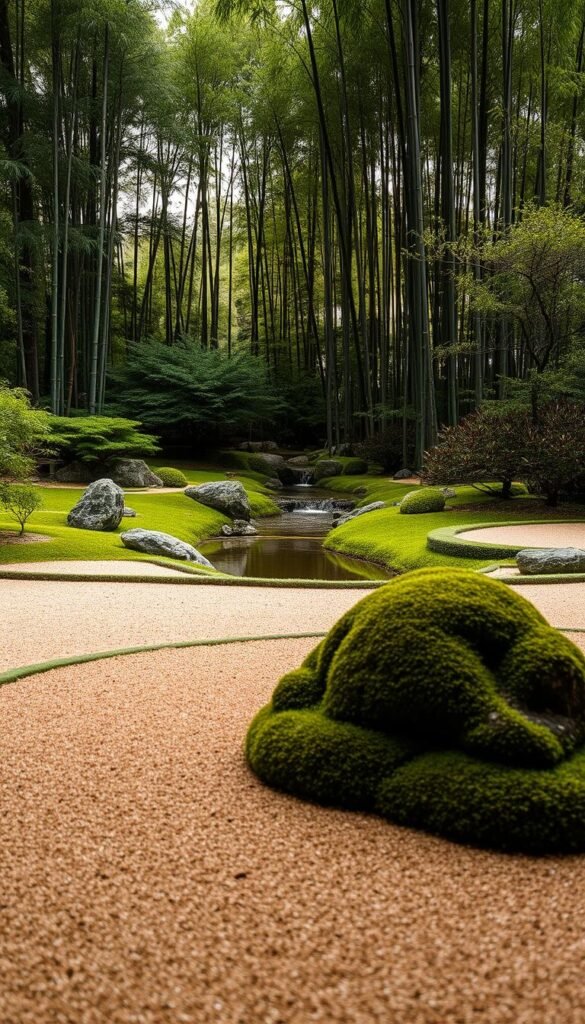
True mastery lies not in what you add, but what you leave out. Head Priest Masuno reveals how modern creators maintain ancient practices: “I immerse myself in every stage—from blueprints to stone selection—like the ishidate-so monks.” This hands-on approach ensures every element serves a purpose.
Time-Honored Techniques and Essential Practices
Discover the power of yohaku—strategic empty spaces that let your mind wander. Masuno explains:
“Silence conveys mental clarity. This void appears visually as yohaku, directly rooted in Zen philosophy.”
These blank areas create tension with rocks or plants, drawing viewers deeper into contemplation.
The “beauty of subtraction” transforms crowded spaces into focused experiences. Remove one non-essential element today—you’ll notice how remaining features gain strength. This principle works whether designing a sprawling authentic Japanese garden or a small patio corner.
Selection matters as much as placement. Master designers choose stones for their role in the whole composition, not just individual appeal. A weathered boulder might anchor the space, while smooth pebbles suggest movement. Every decision feeds the garden’s silent narrative.
Step-by-Step Guide to Creating Your Japanese Garden Oasis
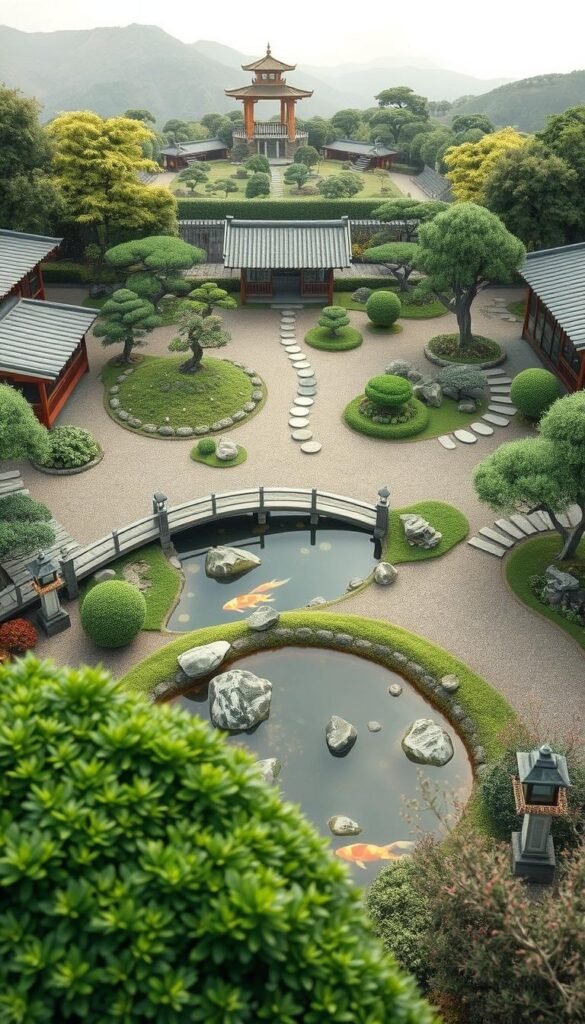
Transform your outdoor area into a peaceful retreat with these practical steps. Begin by observing how sunlight moves across your yard and where shadows linger. Many classic plants thrive with 4-6 hours of daily light, while shaded spots work for mossy accents.
Selecting the Perfect Location and Layout
Map your property’s natural features first. Note slopes for drainage and flat zones for seating areas. A quiet corner near your home invites daily enjoyment, while distant spots create secluded sanctuaries.
| Factor | Ideal Feature | Solution |
|---|---|---|
| Sunlight | Morning exposure | Position maples eastward |
| Drainage | Gentle slope | Add gravel channels |
| Privacy | Existing trees | Use bamboo screens |
| Access | Path width | 36-inch stepping stones |
Choosing Authentic Plants, Stones, and Water Elements
Select specimens that mirror natural landscapes. Dwarf conifers add year-round structure, while cherry blossoms offer spring drama. For stones, combine vertical “guardian” rocks with flat stepping stones.
| Plant | Seasonal Impact | Design Role |
|---|---|---|
| Japanese Maple | Autumn color | Focal point |
| Bamboo | Year-round | Sound barrier |
| Moss | Summer texture | Ground unity |
| Azalea | Spring blooms | Color accents |
Water elements needn’t be complex—a stone basin catches rain or reflects moonlight. Pair flowing streams with smooth pebbles to amplify soothing sounds. Remember, every choice should whisper calmness, not shout for attention.
Design Techniques: From Karesansui to Tea Gardens
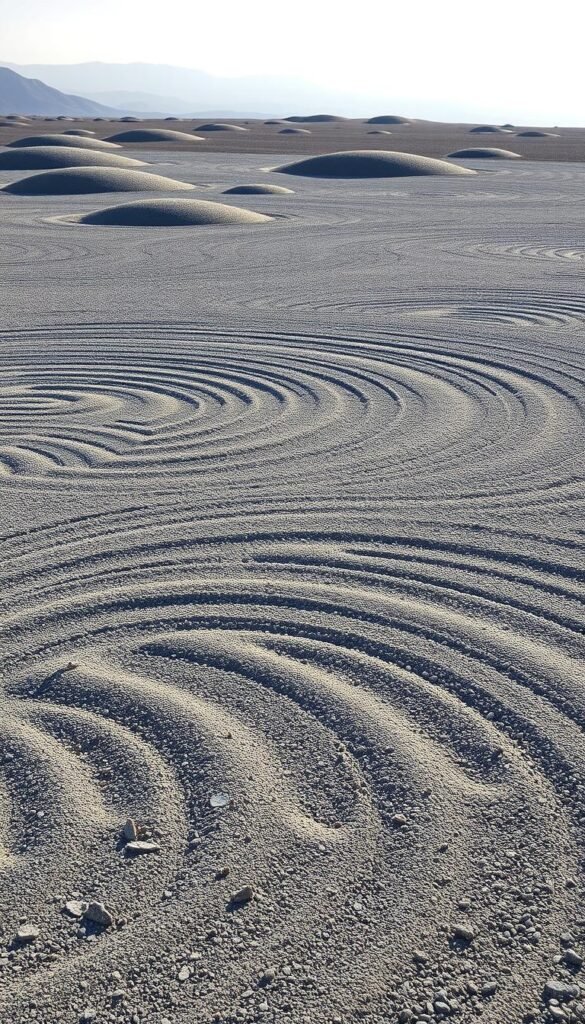
Every raked line in gravel tells a story of seasons and stillness. These methods transform simple materials into living art that engages both hands and mind. Let’s explore how empty spaces and purposeful elements work together.
Crafting Dry Landscapes and Raked Gravel Patterns
Karesansui turns stone and gravel into imaginary seascapes. Arrange rocks as islands surrounded by “water” made from raked sand or crushed granite. Morning light casts long shadows that make patterns pop, while sunset softens edges for twilight calm.
The act of raking becomes meditation. Circular swirls around boulders mimic flowing streams. Straight lines suggest winter frost, while wavy designs echo summer breezes. Change your pattern monthly to match nature’s cycles.
| Pattern | Meaning | Best Season |
|---|---|---|
| Concentric circles | Water ripples | Spring |
| Parallel lines | Calmness | Winter |
| Wavy curves | Stream flow | Summer |
| Crosshatch | Harvest fields | Autumn |
Incorporating Bridges, Stone Lanterns, and Pathways
Chaniwa (tea spaces) use stone lanterns to mark ceremony stages. Place them near water basins or where paths bend—their warm glow guides night visitors. Choose lanterns with open tops to cast moonbeam patterns.
Pathways control movement and mood. Use irregular stepping stones to slow walking pace. Gravel walks crunch underfoot, announcing arrivals. Wooden bridges over dry streams symbolize life’s transitions.
| Element | Purpose | Placement Tip |
|---|---|---|
| Stone lantern | Ambiance | Near seating areas |
| Bridge | Transition | Over symbolic water |
| Stepping stones | Pacing | Every 24 inches |
Remember: less decoration means stronger impact. Let each rock’s texture and gravel’s rhythm speak louder than crowded details. Your space becomes a mirror reflecting inner peace.
Practical Tips for Installing and Maintaining Your Zen Garden
Maintaining your peaceful retreat becomes part of its calming magic. Though minimal in appearance, these spaces thrive with consistent attention that honors their purpose. Each task transforms into mindful practice rather than mundane chores.
Routine Care and Seasonal Maintenance Strategies
Refresh gravel beds weekly by raking new patterns—this prevents compaction. Check stone placements after heavy rains, adjusting shifted rocks to preserve their intentional arrangement. Trim plants strategically, removing only what’s necessary to keep natural shapes.
Winter demands gravel protection from ice using breathable fabric. In spring, inspect moss areas for even growth. Summer requires frequent debris removal from open spaces, while autumn invites reassessing balance as leaves fall.
View upkeep as an extension of your space’s serenity. As Head Priest Masuno observes: “Careful maintenance mirrors inner attention—both require presence.” This approach ensures your zen garden remains a living meditation that evolves gracefully through seasons.

